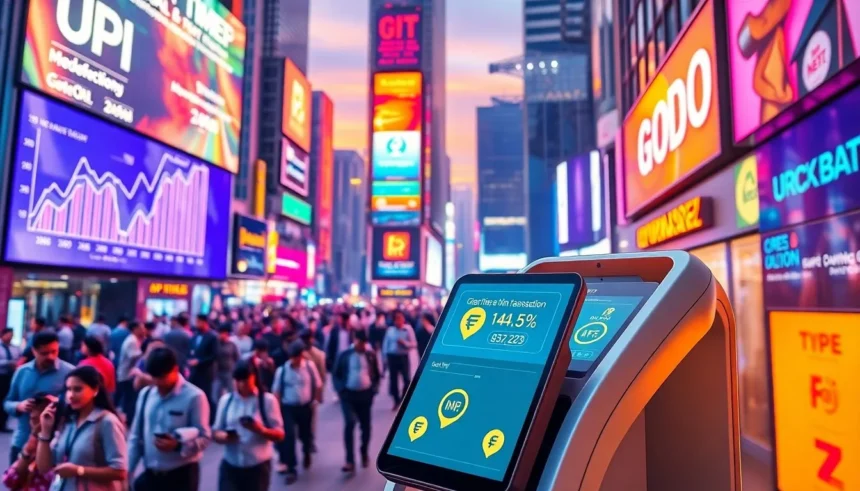In just nine years, India’s Unified Payments Interface (UPI) has transformed from a simple idea into the world’s leading real-time payment platform. Its rapid rise has challenged long-standing giants like Visa and Mastercard. By May 2025, UPI processed Rs 25 lakh crore in transactions, which is twelve times more than all card payments combined. This milestone signals a sea change in how countries think about digital money. It’s not just about India anymore—UPI’s success sends a loud message about the future of payments everywhere.
The Rise of UPI: A Brief Overview of Its Journey
Background and Launch of UPI
UPI was launched by the National Payments Corporation of India (NPCI) in 2016. The goal was clear: make everyday payments simple and bring more people into the financial fold. The system was designed to be easy, quick, and secure. Almost overnight, it started transforming how Indians paid for everything—from groceries to government services.
Key Growth Milestones
During its nine years, UPI hit major milestones. First, it saw a steady rise in users and transaction volumes. Governments and regulators threw their support behind the system, pushing policies and programs to boost adoption. Public confidence grew as more people saw the ease of using UPI for daily transactions. By 2025, it became a household name not just in India but also gaining recognition abroad.
Factors Fueling Rapid Adoption
Why did UPI grow so fast? Several reasons play a part:
- It’s incredibly easy to use. Just a few taps on your smartphone, and money moves instantly.
- As smartphone use skyrocketed, more people gained access to UPI.
- Its low cost makes it attractive for merchants and consumers.
- Advanced security features build trust and prevent fraud.
All these factors combined made UPI the favorite choice in many parts of the country.
UPI’s Supremacy: Key Data and Comparative Analysis
Transaction Volumes and Value
In May 2025, UPI handled Rs 25 lakh crore worth of transactions. To put that into perspective, it’s twelve times higher than what Visa processed globally during the same period. This massive volume highlights UPI’s dominance in real-time payments. No other system has seen such explosive growth in such a short span.
Market Penetration and User Base
India has over 300 million active UPI users. Globally, many countries are now exploring UPI’s technology, increasing its reach. Its user-friendly interface, combined with widespread smartphone use, has created a diverse demographic base. Whether you’re a small shop owner or a tech-savvy teen, UPI is likely your go-to payment option.
Impact on Card Payment Systems
As UPI gains popularity, traditional card systems like Visa see their volumes shrinking. Consumers and merchants prefer UPI because it’s faster and often cheaper. The push towards contactless, cardless payments is changing how money moves worldwide. Visa and Mastercard are now playing catch-up, trying to meet the new demand for instant, digital transactions.
Global Impact and Recognition of UPI as the Top Payment System
International Expansion Efforts
India isn’t keeping UPI’s success to itself. Countries like Bhutan, Nepal, and Singapore are adopting UPI infrastructure through partnerships. These nations see UPI as a way to boost their own digital economies. But expanding across borders isn’t simple—each market has its own rules, security concerns, and technology needs. Still, UPI’s model offers a promising blueprint for others.
Industry Recognition and Support
Top financial leaders and regulators have praised UPI. The Reserve Bank of India (RBI) and NPCI have highlighted its achievements repeatedly. Global financial institutions are watching UPI’s rise, seeing it as a new standard. Governments recognize UPI’s potential to reduce cash dependency and increase financial inclusion worldwide.
Why Surpassing Visa Matters
Breaking Visa’s dominance isn’t just a symbolic victory—it signals a shift in global payment norms. UPI’s success sets a benchmark for fast, secure, and easy payments. As other countries take note, they’re eyeing UPI as a possible blueprint for their own systems in the future.
Future Outlook: Trends and Innovations in UPI and Digital Payments
New Technologies on the Horizon
UPI is just getting started. Future updates may include integration with artificial intelligence (AI) for smarter transactions or blockchain for added security. Biometric authentication could make payments even faster and safer. These innovations will likely reinforce UPI’s lead.
Changing Policies and Cross-Border Payments
Regulators are already working on ways to extend UPI’s reach globally. Cross-border UPI transactions could become common, connecting different countries’ payment systems seamlessly. Such advancements will help businesses and travelers alike.
Benefits for Consumers and Merchants
More people will access banking and payment systems thanks to UPI’s broad reach. Users will experience quicker, smoother transactions. Meanwhile, merchants benefit from lower costs and increased sales. For both, UPI offers a better, more inclusive financial future.
Conclusion
The story of UPI’s rise shows how imagination and innovation can shake up long-standing systems. Surpassing Visa marks a turning point in digital payments worldwide. It proves that simplicity, security, and speed are the keys to winning consumer trust. As UPI continues to grow and expand, it paves the way for a future where fast, free, and secure payments are the norm everywhere. Everyone in the payments ecosystem should be ready to adapt and embrace these changes—because the future is already here.

